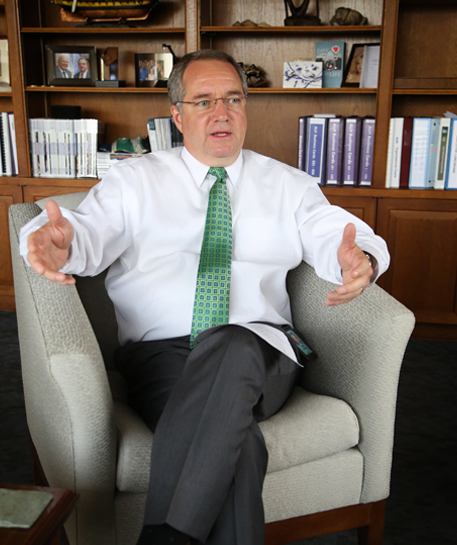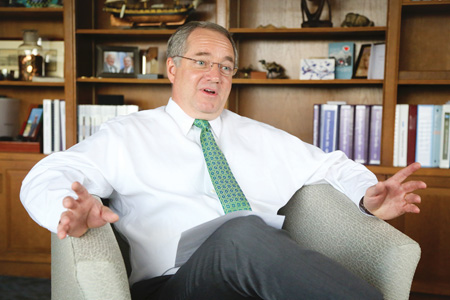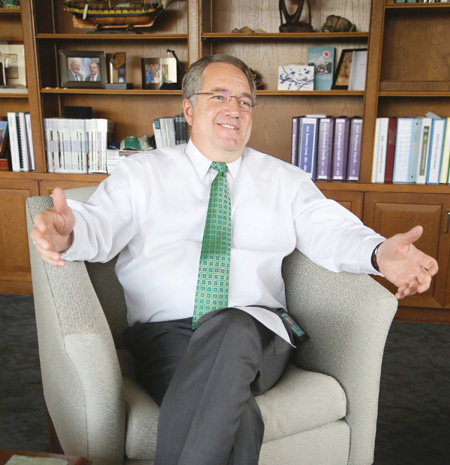It’s been just over a year since you became president of SwRI. What is the greatest adjustment you’ve had to make?
I think it’s managing the demands on my time. The Institute is such a well-recognized and admired organization that people from across the city, state, and, in fact, the nation are interested in the Institute. In my position, I get numerous requests to speak at functions, participate on boards, and attend other events — much more than I can possibly accommodate. In my first year, however, the biggest demand on my time has been learning about the Institute. I really admire (Executive Vice President) Walt Downing, because he has an almost encyclopedic knowledge of what the Institute has done and is currently doing. While I’m not sure I’ll ever be that well informed, every day I learn as much as I can, and I try to help define where we’re headed in the future.

Adam L. Hamilton, P.E., has served since September 2014 as SwRI’s fourth president in its 68-year history. Prior to his appointment, he was president and CEO of Signature Science LLC, a for-profit subsidiary of SwRI specializing in national security, biotechnology, chemistry, environmental science, and engineering. His multidisciplinary technical expertise includes engineering, biological sciences, chemical sciences, space sciences, mathematics, modeling, quality assurance, software development, and risk assessment.
How do you compare being the CEO of a for-profit firm like Signature Science to managing a diversified, nonprofit R&D facility of 10 divisions?
My time as CEO of Signature Science was all under the tutelage of Southwest Research Institute. Signature Science is a subsidiary of the Institute and is a for-profit company. However, net income is not less important to the Institute than it is for a company like Signature Science. There is a saying here that “SwRI is not for profit, but we’re not for loss, either.” Our net income allows us to re-invest and innovate, and to continue contributing to the scientific and technical communities.
How have national and international trends in research and development changed in the past few years, and in what direction are they headed?
We have all witnessed the virtualization of research. Some of the research and analysis that we do can also be done by organizations that don’t have the infrastructure we have. So we must continue to try to find research and technology applications that make use of our current and future infrastructure. In addition to our staff, our facilities and infrastructure separate us from other research and technology organizations and allow us to offer unique value to our clients. For example, information technology is a field we must continually evaluate for investment and development purposes. The challenge is that most of our competitors in this field have limited physical infrastructure, so it’s more efficient for them, and more challenging for us, to compete in that marketplace. The second thing I see is the speed with which developments occur now. Scientific and technical advancements are happening so quickly, it’s difficult to develop and maintain intellectual property that is not perishable. However, we also benefit from the more rapid advances; our staff members are agile and constantly seek new ways to solve our clients’ scientific and technical problems. So, the virtualization of technology applications, and the acceleration of scientific development and application are two trends that are of greatest interest.
Tell us what you consider some highlights of your first year on the job at SwRI.
I continue to be surprised by the technical accomplishments that this organization has made over the past 68 years. It seems as if success is inculcated in our culture with the expectation to continue, and I am proud to be a part of this Institute. I’m also excited about what this organization is going to be doing in the next five, 10, 15, and 20 years, because I believe we have not only a tremendous history but an exciting future.

The other thing that’s been fun to discover is the flavor of the culture here. You can see from the outside that the Institute is a tightknit group, with a lot of loyalty and longevity. But from the inside, you can really see how closely connected the employees are to the organization, to each other, and — what’s really remarkable — to the community. This organization has people who really care about where we live and the people who live here with us. And they show that every day.
Do you recall what you were doing when the New Horizons spacecraft made its flyby of Pluto and Charon last July?
I was fortunate enough to be invited to Johns Hopkins University Applied Physics Laboratory for the flyby. I had the privilege of visiting with the son and daughter of Clyde Tombaugh, the scientist who first discovered Pluto. I was sitting on the front row next to them as Dr. Alan Stern led the countdown to the flyby. We all celebrated the event, basically a tick of the clock, when the New Horizons spacecraft flew by Pluto at its point of closest approach. That was something I’ll never forget. The second important event occurred hours later, when the spacecraft successfully communicated that it had survived beyond the point of closest approach, before we saw the first images. Once we received the initial telemetry indicating that all systems were operational, we knew the spacecraft was healthy and there would be lots of data to fuel our scientific discoveries. I’d been able to attend launches in the past, and the flyby was similar to a launch. Everybody is waiting for that one event, and when it happens, there’s shared joy and excitement.
How does being a research engineer compare to managing a lot of research engineers, where you don’t get to do hands-on research – or do you?
I miss the hands-on scientific and technical work. I try to maintain technical competencies by listening to our researchers and touring our laboratories. But I do miss focusing on a technical problem and developing a solution that clients appreciate. You get a real sense of accomplishment when you have a technical breakthrough or make something work where others have had difficulties. However, like the Pluto flyby, I get to share in many of those breakthrough moments. I also try to keep my technical skills current by frequently reviewing scientific and technical literature. I read (although not in entirety) about 15 journals and periodicals to at least stay involved and cognizant of the developments in several technical fields. I like to share that information with our staff when I can. But I do miss the hands-on work. My indulgence now is building my own PowerPoint presentations and spreadsheets.
What’s been your favorite discovery at SwRI?
Frito Pie in the cafeteria on Friday (laughs). But seriously, I am likely to continue learning about the Institute’s accomplishments for years to come. The rich history of our organization has been awe-inspiring. If you look back on some of the greatest contributions that we’ve made, you can see the impact that our work has had on everyday life. We have contributed to science and technology in so many different ways while maintaining our mission to serve mankind through science and technology. I enjoy visiting our library and seeing some of the historic texts, listening to a lecture on a historic textbook, or reading in our newsletter about a program that we conducted 50 years ago. To me this organization has an amazing history. It’s fun to be a part of it and to know that what we’re doing today, right now, is going to be viewed similarly in the future.
What is a typical day on the job at SwRI?
This is not a job, and neither was Signature Science. Signature Science was very much like my first child. It’s all grown up now, but I still care about it and think about it. Now, the Institute is really at the forefront of my thoughts, from the time I wake up until the time I go to bed. In the morning I have to think about what engagements I have that day, who I’m meeting with. On the way to work, I’m thinking about the things I need to get done — what are my highest priority tasks and what should I probably let go? A typical day is about half-scheduled. That is, about half of my time is scheduled with appointments and meetings. But I have to leave about half of my time for the unforeseen things that happen every day that need my attention and time. In addition to administrative and fiduciary functions, I also spend a lot of my time with the staff and our clients. I enjoy developing relationships with our employees and key partners here in San Antonio, like The University of Texas at San Antonio, the UT Health Science Center at San Antonio, and Texas Biomedical Research Institute. Also, I enjoy participating in organizations that give back to the community, such as the United Way, where I’m honored to participate as a board member. Much of my time is also spent at meetings disguised as meals. This last year, I set a new record, a personal best: Three breakfasts in one morning, all organized by different entities. Many lunches are occupied with meetings of boards, and evening and weekend functions are work-related as well. So it’s really more than a job. It’s a lifestyle, and a lifestyle I’m quite honored to have.

What do you think are the top three challenges SwRI faces in the short term?
All organizations face some issues or impediments to what we want to do, which is to continue to grow. Right now, I think the principal impediments to SwRI’s growth are related to politics and government spending. Sometimes, the need to invest in the science and technology that we can provide is overshadowed by politics. That’s a shame, and it makes it difficult for us. But we’ve made some strides in that area and have done very well. The next problem is currently related to oil prices, because we do a lot of work for clients in oil and gas and energy. With abundant supply and low prices, some of the motivation to invest in the research and development that we are really good at has waned.
Not all — some people have the foresight to continue to invest, and when they do, they invest in the best. So, we haven’t been hit too hard by the declining oil prices, but, the longer that trend continues, the more likely we’ll see some setbacks. Lastly, regulations, policies, procedures, and bureaucracy can impede our success. However, we have a way of satisfying all of these requirements and still being successful. Specifically related to taxes, we anticipate that our health benefits for employees may be heavily taxed starting in 2018, so we are trying to develop adjustment and coping strategies. And government auditing and oversight has become very costly — not because of anything the Institute has done — but because other organizations have had issues and problems. The level of oversight is definitely burdensome. So we are always trying to satisfy new requirements and to improve transparency and accountability with the way we manage the Institute’s finances.
Having had only four presidents in 68 years, Southwest Research Institute obviously takes a long-term view when it comes to planning. What is your main long-term goal for the Institute?
Sustainability. That’s the minimum — to sustain the research in science and technology applications that we provide here at the Institute. And closely associated with that is growth. We need to continue to grow, because that provides the best environment for our staff. Our staff members are incredibly talented, and with talented people you always have to make sure they have a satisfying career and development path. That path includes growth as they become more involved in overseeing larger programs, managing people, and being leaders. You have to have more and bigger programs to satisfy those needs and to bring in new staff, and to provide opportunities for those new staff members as well. So, that’s the mission. We’ll do what we need to do in science and technology, consistent with our mission statement, and seek out ways to grow revenue. That will allow us to continue our history of growth and provide rich opportunities for our staff so that they can have long, successful careers.

